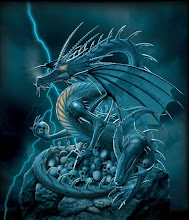For a long period of time, certain people, especially the Chinese, have believed in the existence of one most-feared, all-wise mythical creature,
DRAGONS. They expected a monstrous lizard, scale as hard as steel, completely invincible, with two bat-like wings that may reached meters if spread from tip-to-tip, not to mention the ear-splitting roar and the magnificent fire!
But do dragons really exist???
Yes, dragons do exist. Based on the features and all, anyone can see that dragons of the myth may have connection with the reptiles in reality, I mean, anyone can see the resemblance, from the pointed snout to the splayed legs and scaly bodies. But the dragon I'm talking is, sadly-speaking, lack the wings. In fact, they run on all fours and not only that, they are very,very good swimmers! They can swim in the open seas...quite frightening don't you think? So what are these dragons?
It is none other than the one and only KOMODO DRAGON!
Found on only a few Indonesian islands, these lizards could reach up to 3 meters (10 feet) in length and they can weight up to 70kg. These dragons mostly eat dead animals (according to Disney's Children's Encyclopedia) but they can kill deers and wild pigs, and are known to attack humans, if threatened and if they are ravenous.
Discovered 100 years ago by a plane-crashed pilot, these world's largest lizards, despite their enormous features, can run very fast with a speed up to 12 mph (about 20 km/h) and even more when they hunt! They usually look slow, but in an instant could reach a maximum speed! They attack running subjects and may hurt humans, but they DO NOT eat humans.
How do they REPRODUCE???
About between 15 to 30 eggs is layed by a single female, and the eggs will stay put during incubation period of 8 to 9 months. Like every reptile, the birth is a very critical moment, as the babies are helpless and fragile, and there are many predators about. These babies measure about 30 cm long, and will sexually mature around 6 to 10 years old.
Funny fact is, cannibalism is common thing among these lizards. The old ones always try to 'do-in' the younger ones, or devour them, so the little dragons have to climb up a tree and hide. Generally the young ones is green with stripes to help them hide. They survive on insects, eggs and birds and when they are old enough to fight and survive to the bigger Komodo dragons, they will go down and change their diet to bigger animals.
However,recently, researches have found out that the females are Parthenogenesis, which is a form of asexual reproduction. Which means, the female is completely able to reproduced without having to mate.
Read more ...









